5 October 1778 Monday
250 large drawings of the Trajan column, finished in black pencil, and a quantity of engravings by Voulet and other famous artists; more, 6
illuminated drawings by Després.
300 drawings of the city of Pompeii, the theater of Hercolanum and the museum of Portici, with plans and descriptions.
Various manuscripts enclosed in a box and forming 200 bundles, works of great erudition by Piranesi, which had cost him fifty years of work and which he had not yet published.
24 volumes of compositions, drawings of antiquities by Piranesi.
60 drawings of views of Rome, Tivoli and Frascati, and two large drawings by Philippe Ackert, of great merit.
50 drawings of ancient statues of different sizes, by very renowned artists.
All the correspondence and other papers, for 40 years, which concerned the house and the calcography; a selected library of works interesting science, fine arts and diplomacy.
300 drawings of the excavations made in Rome for 40 years, with their elevations, which were to serve to provide a plan of the ancient city of Rome.
250 drawings of the plans with the elevations of the Villa Adriana, in Tivoli, by Giovanni Battista and Francesco Piranesi; 140 drawings of the plans and elevation of the Circus of Caracalla.
150 drawings of the Baths of Caracalla, Diocletian and Titus, with description; 60 drawings of ancient ships, with description; 12 drawings of Egyptian obelisks; 180 drawings of the most sought-after ornaments by the most famous artists; 25 drawings of Caprarola Castle, with plans and elevations.
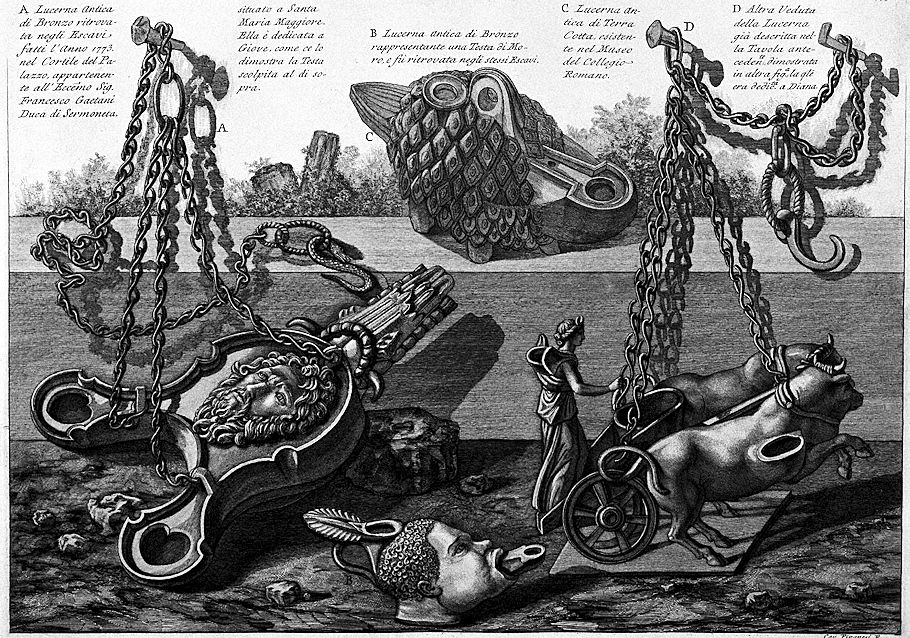
47 y.o. Francesco Piranesi 1805
Le Antichità della Magna Grecia Parte III

Glass caraffe and vases, with faceted cut crystal goblets, used for different purposes and found in Pompeii.
Drawn and Engraved by F. Piranesi Year 1805
5 October 1803
Even though John James Audubon has been at Ury for over a month now, upon waking up each morning he still immediately goes out to the southeast field beyond the tree line to see what the buffalo are doing. Oh give me a home where the buffalo roam indeed.
5 October 1812 Monday
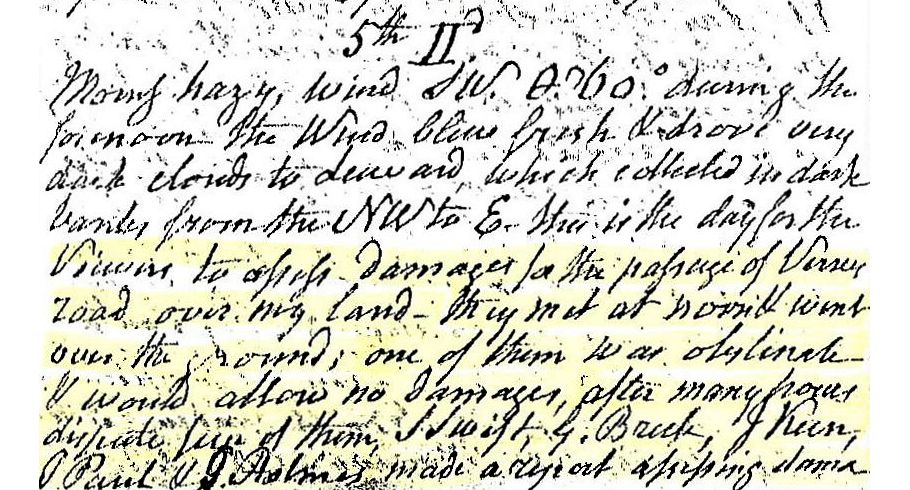
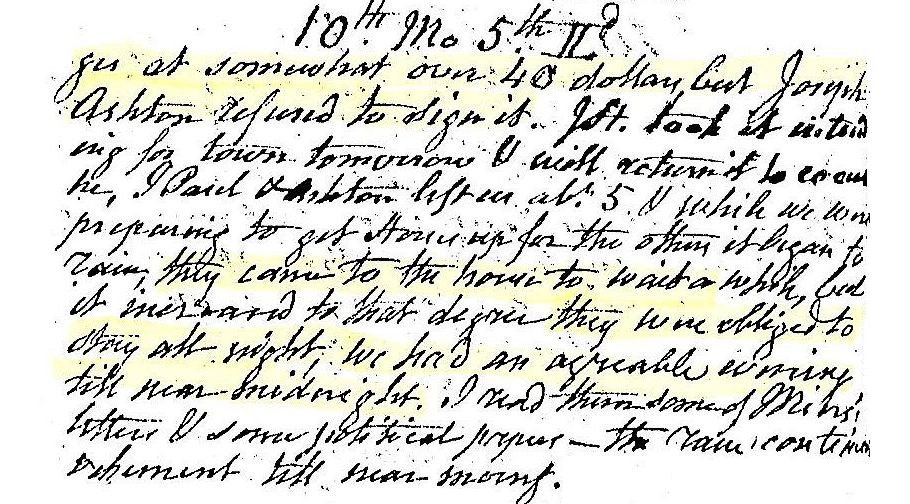
Morning hazy, wind SW, temperature 60°. During the forenoon the wind blew fresh and drove very dark clouds to leeward which collected in dark banks from NW to E. This is the day for the viewers to assess damages for the passage of Verree Road over my land. The met at noon and went over the ground; one of them was obstinate and would allow no damages. After many hours of dispute, five of them S Swift, G Brick, J Keen, J Paul and I Holmes made a report assessing damages at somewhat over 40 dollars, but Joseph Ashton refused to sign it. J St. took it intending for town tomorrow and will return it to c.......[?] J. Paul and Ashton left us about 5 & while we were preparing to get horses up for the others it began to rain, they came to the house to wait a while, but it increased to that degree they were obliged to stay all night. We had an agreeable evening till near midnight. I read them some of Miers [Jr.]'s letter and some political papers. The rain continued vehement till near morning.
5 October 1994
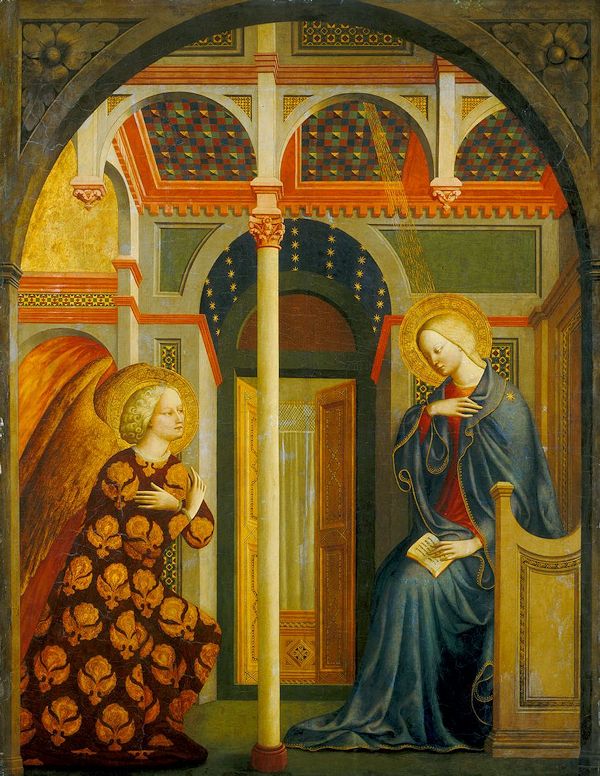
1.
The story begins with my visits to the National Gallery in Washington D.C. in the summer of 1981. In the main galleries I was most attracted to the Renaissance paintings. I was looking for inspiration in choosing colors for the walls of my house in Philadelphia, which I recently received from my parents, and wanted to renovate as soon as I got home from my summer in Washington. I was looking at all the paintings that had architectural backgrounds, because the walls in these backgrounds were most times painted in bright saturated colors. These paintings seemed to be the only place where I could see such vivid colors used as wall decoration. In any case, it got me very involved with many different Renaissance paintings.
While on my search for color inspiration, I became intrigued by a certain aspect of The Annunciation (1425-30) by Masolino da Panicale. What intrigued me was the awkward, and almost stupid, placement of a column between the Angel Gabriel and the Virgin Mary. The column, together with the pilaster it supports, go from the bottom edge of the painting right up to the top edge, virtually dividing the painting in half. Even though the column's placement seemed unsophisticated, it was the column's visual dominance that made me immediately wonder as to the meaning and possible symbolism of its placement within the picture field. The artist's placement of the column seemed deliberate and intentional.
Just looking at the painting, without going into any analysis, there are a number of aspects that are self-evident. The column is just slightly off center. The line produced by the column goes straight from the bottom edge of the painting to the top edge of the painting, virtually cutting the painting in half. Proof of the column's intentional inclusion and placement within the composition is presented by the fact that all the other arches of the overhanging porch do not have columns to support them. The column is also the only element of the painting which is shown complete, uncropped or unobstructed. All other elements of the painting are cropped or partially obstructed, even the gowns of Gabriel and Mary. And in an almost bizarre way, it looks as though Gabriel and Mary are both paying homage to the column.
2.
There are a few more ideas/questions that occur to me while looking at the reproduction of the painting (Masolino's Annunciation):
a. the open door in the central background and what it might symbolize.
b. the fact that the rays of light from Heaven are coming from under the canopy.
c. the gold star on Mary's left shoulder.
3.
I had come up with two interpretations of the column and its placement in the painting. Religiously, the column could easily be seen to represent the still existent separation between God and man, a separation that began in with the Fall in the Garden of Eden. The Annunciation, both in the painting and in Christian theology, is the reunion of God and man. The Annunciation is also the Incarnation, the feast of God becoming flesh. Compositionally, the column divides the painting in half, thus virtually turning the painting into a diptych, a two panel painting. There is, however, an ambiguity created in that the column only implies a diptych. The painting is divided in half, but it is also still all in one piece. Taking both interpretations into consideration, one could conclude that that artist wished to express not only a duality, but more precisely, the resolution of a duality.
4.
To find reassurance for my hypothesis, I looked for other Annunciation painting in the Renaissance galleries of the National Gallery. To my surprise, and delight, I immediately found two other Annunciation paintings that had prominent columns dividing the compositions in half. The two painting are Giovanni di Paola's Annunciation (1445) and Fra Filippo Lippi's Annunciation (probably after 1440). The Lippi painting, in particular, has an exceedingly strong division created by a centrally located column. The di Paolo painting does not have a dominant column going from top to bottom, but the column in the painting does mark a central vertical division. What this painting lacks in a full length column, however, is made up with a scene of the Fall from the Garden of Eden, depicted outside the porch and behind the Angel Gabriel. This painting, therefore shows both the beginning and the end of the division between God and humanity.
5.
The Annunciation is both an end and a beginning - the end of the separation between God and man and the beginning of the union of God and man. These Renaissance artists are specifically showing the cutting-edge aspect of this holy event. Were they to depict the Annunciation as an actual diptych, the separation between God and man would be too pronounced. These artists wanted to illustrate the division between God and man just as it was about to end, i.e. just as the duality was about to become a singularity. The artist's solution was to use a devise that would divide the composition visually in half, but not literally in half. In this light, the column is an apt compositional devise. Even in actual built architecture, a colonnade clearly demarks a boundary, yet the boundary is one that is easily crossed over. The idea of ambiguity is again part of the picture.
These Renaissance artists have depicted the end of the separation by painting the column directly on the picture plane. The division is on the exact same level, both literally and physically, as the Annunciation itself. These artists have creatively rendered the very meaning and concept of the Annunciation.
6.
All three paintings were painted within 20 years of each other: 1425/30, after 1440, c.1445. Are there some theological writings or papal sermons from the same period that influenced there artists?
7.
Well, now comes the jump, leap, connection between the duality of God vs. Man and man's two legs. The first person I ever told this story to was Dave Schmitt. He had a picnic at his parents house and pool at the end of summer 1981. (I think he was living at his parent's home at that time.) Anyway, I started to tell him my story (ideas) by saying, "Many Renaissance Annunciation paintings are implied diptychs for the same reason that man has two legs." He looked at me quizzically, and I went on with my story. Before I go on here, however, I want to explain how I made the leap between duality/division of God and Man and man's (human being's) two legs.
8.
I have already discussed the idea of an implied diptych created by the column in Masolino's painting. I gave some thought back in 1981 to the nature of a diptych itself, as well as how the implied diptych was used to represent the still existent, but about to be resolved, division between God and man. Diptychs first implied (and still do imply) to me a duality. I, at that time and probably still am now, was well aware, and perhaps even influenced, by what Robert Venturi wrote about duality in his book Complexity and Contradiction in Architecture, 1966, p. 90 in the chapter "The Obligation Towards a Difficult Whole" I was probably also influenced by having read Circle and Square in the Square of St. Peter's (summer 1977 - when I worked at C. W. Fox's office).
5 October 1999
who's on first?
The following excerpt comes from Johan Huizinga's Homo Ludens - a study of the play element in culture:
"The player who trespasses against the rules or ignores them is a "spoil-sport". The spoil-sport is not the same as the false player, the cheat; for the latter pretends to be playing the game and, on the face of it, still acknowledges the magic circle. It is curious to note how much more lenient society is to the cheat than to the spoil-sport. This is because the spoil-sport shatters the play-world itself. By withdrawing from the game he reveals the relativity and fragility of the play-world in which he had temporarily shut himself with others. He robs play of its illusion -- a pregnant word which means literally "in-play" (from inlusio, illudere or inludere). Therefore he must be cast out, for he threatens the existence of the play-community. . . . In the world of high seriousness, too, the cheat and the hypocrite have always had an easier time of it than the spoil-sport, here called apostates, heretics, innovators, prophets, conscientious objectors, etc. It sometimes happens, however, that the spoil-sports in their turn make a new community with rules of its own. The outlaw, the revolutionary, the cabbalist or member of a secret society, indeed heretics of all kinds are of a highly associative if not sociable disposition, and a certain element of play is prominent in all their doings."
5 October 2000
Hebron (almost 1700 years ago)
Hebron is biblically famous for two sites, the place where an Angel of God first appeared and spoke with Abraham, and the place where Abraham and his family are buried. Both places were then called Marne.
At a later time (c. 324) when Helena Augusta (St. Helena, the mother of Constantine the Great) was building (the first) Christian churches at the sites of the Nativity (where Christ was born) and of the Ascension (where Christ rose into Heaven), Eutropia, Constantine's mother-in-law was restoring the sites at Hebron (which apparently were in complete disregard at that time). These obscure facts are recorded by Eusebius in his Life of Constantine.
The role of Eutropia as a Christian is quite remarkable because her husband, the (co-)emperor Maximian (ruler in the western Empire while Diocletian ruled the eastern empire) was perhaps the most notorious persecutor of Christians in the decades just prior to the rule of Constantine. Moreover, it is strange to consider that Helena and Eutropia may have been acting as a team. Eutropia was not only (second) mother-in-law to Constantine, but also the (second) mother-in-law of Constantine's father, Constantius, who after divorcing Helena married (Eutropia's daughter) Theodora. And finally, Eutropia's Christian mission would seem altogether most unlikely because her husband Maximian and her son, the usurptive emperor Maxentius, both died trying to resist Constantine.
I mention all this because I find it fascinating that after the leading men of the early fourth century Roman empire where busy fighting and killing each other, the leading women of the early fourth century Roman empire were busy building churches and restoring holy sites. Very metabolic.
5 October 2022 Wednesday
Man arrested after attacking ancient sculptures at Vatican Museums in Italy
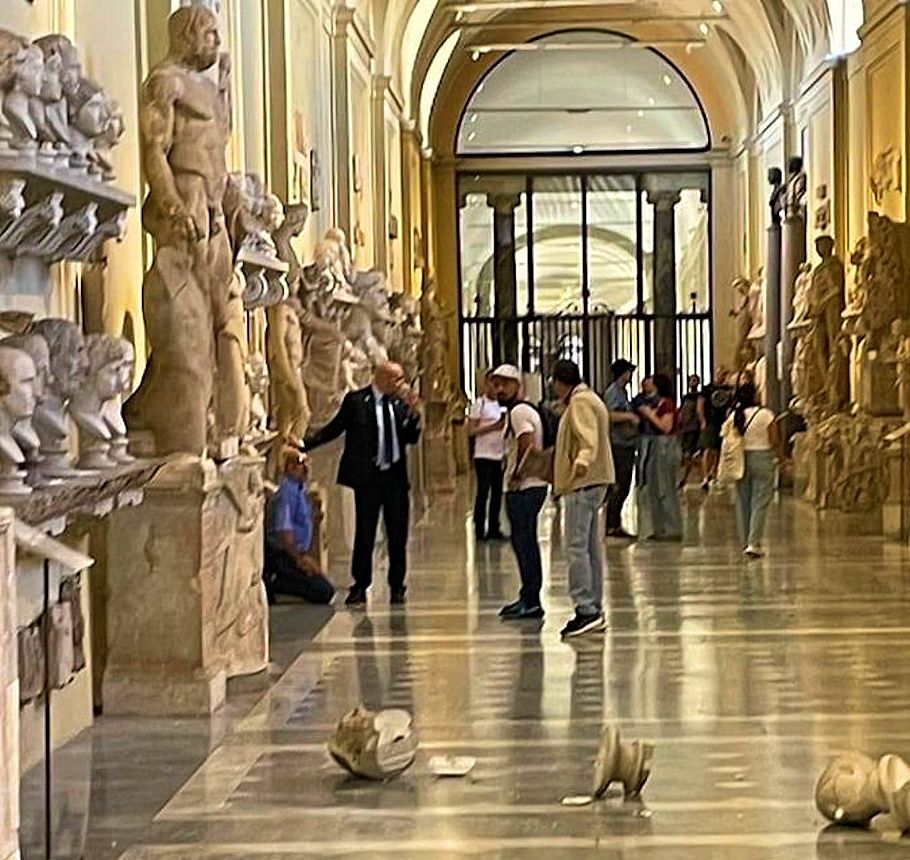
"A 65-year-old man has been arrested after toppling two ancient busts in the Vatican Museums on Wednesday. The artefacts have sustained moderate damage and have been taken to the museum's in-house restoration lab for repair... The man, an American citizen who was born in Egypt, was stopped by the Vatican police in the Chiaramonti Museum—a long corridor lined with statues and busts—shortly after he threw the busts to the ground... The visitor—who has previously been reprimanded in the US for gross indecency—was in Rome on a three-day trip and told officials that he wanted to see the Pope." --James Imam
This reminds me of Laszlo Toth's attack on Michelangelo's Pietà in St. Peter's Basilica 21 May 1972.

No Doubt the Artist Suffered as Well
"Generally Piranesi avoided dealing in statues or busts, the most competitive end of the trade, although he did, for instance sell Charles Towneley a large head of Hercules from Tivoli. Instead he concentrated on supplying urns, coffers, candelabra and other decorative items which could be freely exported. He ruthlessly cannibalized the decorative fragments which he bought quite cheaply to be made up into elaborate structures, tiered like wedding cakes, or to be cut into panels for his chimney pieces. These were all displayed in the museum which he laid out in some of the rooms of his house; it was an art gallery rather than a museum and most things were for sale. When an inventory was made shortly after his death over a hundred items were listed in his house and garden and a further two-hundred were kept in a warehouse in the Campo Vaccino. A few years after his death the whole collection was bought off Francesco by King Gustavus of Sweden in exchange for an annual pension of 630 zecchini and was shipped to Stockholm in 1783."
Jonathan Scott, Piranesi (London: Academy Editions, 1975), p. 253.
5 October 2023 Thursday
I'm happy to see an unplanned edginess within the epilogue so far. Certainly not an in-your-face edginess, more a natural edginess, which makes sense because of the at-the-edge position naturally held by epilogues, and today's edginess here is very edgy given the world's present day-to-day stage.
Log 58 arrived with yesterday's mail, but I forgot all about it till this forenoon when I saw it again under an innocuous document destined for the paper shredder. I read several essays this afternoon, including Donald Bates's "Postcards from Venice." On page 65:
Dear C,
Inside the Giardini, just past the Swiss and Venezuelan pavilions, is the Russian Pavilion. Empty. Closed. With a single guard. The pavilion became a photo attraction as the day goes on.
Sincerely
So, the Russian Pavilion is right now closed at the 18th Venice Architecture Biennale. I wonder, am I the only living, western/American architect/artist scheduled to have some of their work on exhibit anywhere in Russia two weeks from now? If true, then it will surely be a most unique and uniquely edgy event within 2023's architecture and art histories--The Timepiece of Humanity within Star Vengeance at the House of Culture, Moscow, 19 October 2023 - 21 January 2024.
Jupiter and Uranus in Taurus 16 May 2023 to 25 May 2024.
|